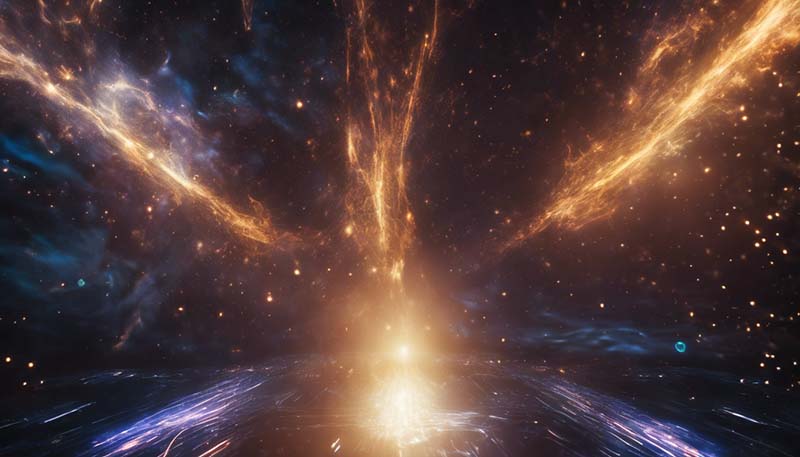Introduction
The concept of dark matter has been a subject of great interest and debate in the scientific community for decades. It is an elusive form of matter that makes up approximately 27% of the universe, yet its true nature remains a mystery. This article delves into the study of dark matter, its implications for our understanding of the universe, and the various theories and experiments aimed at uncovering its secrets.
What is Dark Matter?
Dark matter is a hypothetical form of matter that does not emit, absorb, or reflect electromagnetic radiation, making it invisible to telescopes and other detection methods that rely on light. It was first proposed in the 1930s by Swiss astronomer Fritz Zwicky, who observed that the gravitational forces within galaxy clusters were much stronger than could be accounted for by the visible matter alone. This led him to postulate the existence of a non-luminous, massive substance that influences the behavior of galaxies and galaxy clusters.
Since then, numerous observations and experiments have provided strong evidence for the existence of dark matter. For example, the rotation curves of galaxies show that their outer regions rotate at a constant speed, which contradicts the predictions of Newtonian gravity. This phenomenon, known as the "flat rotation curve," can be explained by the presence of a massive, invisible halo of dark matter surrounding the galaxies.
Direct and Indirect Detection of Dark Matter
Direct Detection
Direct detection experiments aim to observe dark matter particles as they pass through detectors on Earth. The idea is that these particles, which are believed to be weakly interacting massive particles (WIMPs), would occasionally collide with atomic nuclei in the detector, producing a small amount of energy that can be measured. Several underground laboratories, such as the Large Underground Xenon (LUX) experiment and the XENON1T experiment, have been conducting searches for dark matter using liquid xenon detectors. However, despite their increased sensitivity, these experiments have not yet observed any conclusive signals from dark matter interactions.
Indirect Detection

Indirect detection focuses on observing the products of dark matter particle annihilations or decays in cosmic rays, gamma rays, or neutrinos. For example, the Fermi Large Area Telescope (Fermi-LAT) and the High Energy Stereoscopic System (H.E.S.S.) are two observatories that search for gamma rays resulting from dark matter annihilations in the centers of galaxies or near black holes. While some interesting signals have been observed, no definitive evidence for dark matter has been found through indirect detection methods either.
Theoretical Models of Dark Matter
There are several theoretical models that attempt to explain the nature of dark matter. Some of the most popular candidates include:
- WIMPs: Weakly Interacting Massive Particles are hypothetical particles that interact with ordinary matter through the weak nuclear force and gravity. They are a leading candidate for dark matter due to their predicted abundance and the fact that they naturally arise in supersymmetric extensions of the Standard Model of particle physics.
- Axions: These are hypothetical ultra-light particles that were originally proposed to solve the strong CP problem in quantum chromodynamics. They are also considered as a potential dark matter candidate because they are predicted to be abundant and interact very weakly with ordinary matter.
- Sterile Neutrinos: These are hypothetical neutrinos that do not interact through any of the known fundamental forces except gravity. They are an interesting dark matter candidate because they could provide a natural explanation for the observed dark matter abundance.
Implications of Dark Matter for Our Universe
The study of dark matter has profound implications for our understanding of the universe. It challenges the traditional view of the cosmos as being composed primarily of visible matter, and instead paints a picture of a universe where the majority of its mass is hidden from our view. This has led to the development of new theories and models, such as the Lambda-CDM model, which incorporates dark matter and dark energy to explain the large-scale structure of the universe and its accelerated expansion.
Furthermore, the search for dark matter has pushed the boundaries of experimental physics, leading to the development of new detection techniques and more sensitive instruments. This has not only increased our chances of directly detecting dark matter but has also improved our ability to study other elusive particles and phenomena.
Conclusion
The study of dark matter has come a long way since its inception, and while we still have much to learn about this mysterious substance, it is clear that it plays a crucial role in shaping our understanding of the universe. As technology continues to advance and more sophisticated experiments are conducted, we may be on the verge of finally uncovering the secrets of dark matter and its true nature. Until then, the search for this elusive substance will remain one of the most fascinating and important endeavors in modern science.
Leave Your Comments